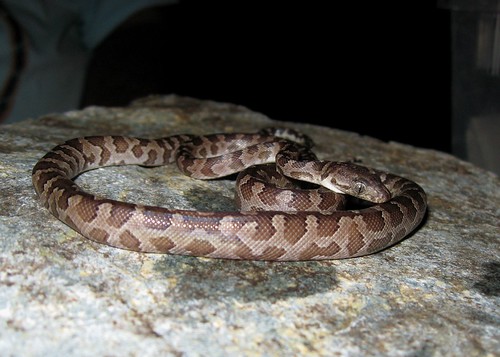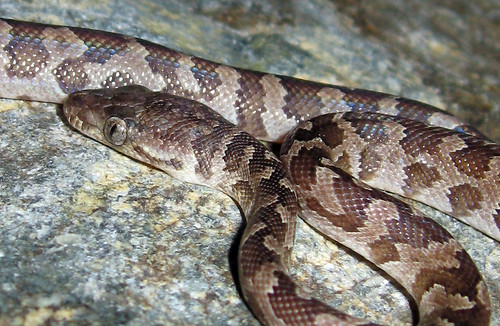Yet another snake, in fact yet another endemic snake of limited range and hence extreme rarity. This is probably the rarest of the 3 so far: Epicrates monensis granti – our dwarf tree boa. This chap perhaps more than the others has suffered the depredations of cats, roads and mongooses as well as habitat loss and has been lost from a number of islands. The good news is it seems to be on its way to recovery of sorts; thriving populations exist on a number of protected small cays and uninhabited islands and there are also good numbers on some of the larger islands in the right habitat. This is a 2 year old snake, captive bred for release and is about 15 inches long maybe. Its just shed its skin hence the awesome colouration.
With regard to the name dwarf boa is a bit of a misnomer – its bigger than any of our other snakes and tops out at perhaps 4 ½ feet. The Cuban Epicrates gets to 16 feet feeding on hutia, chickens and suchlike (no dwarf!) and is apparently rather aggressive. Our species tends to musk you if you pick it up but is really very docile. This is an older animal and as you can see it’s a little less marvellous in colouration – at this size and above he'll eat Anoles and other lizards as well as small birds, nestlings and eggs (and now thanks to man's arrival mice). A big one may take rats just as a big rat may take neonate boas.
One of the really cool things about all Epicrates is they have something in their skin that creates this awesome lustrous sheen as seen on the close up of the 2 year old shown below. That and their patterning and big boa heads makes them really beautiful snakes in my opinion.
That’s 3 of the 4* snakes down then. Plans are a foot to show you number 4. It’s a lot different and rather weird as you'll hopefully see.
[* I believe there are only 4 snakes here. I have seen an abstract of a scientific article suggesting we have a total of 34 herp species. Counting introductions, extinctions and splits I can't quite reach that number which makes me wonder if there may be some other species I'm not aware of on the islands.]
[* I believe there are only 4 snakes here. I have seen an abstract of a scientific article suggesting we have a total of 34 herp species. Counting introductions, extinctions and splits I can't quite reach that number which makes me wonder if there may be some other species I'm not aware of on the islands.]




No comments:
Post a Comment